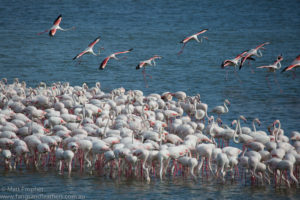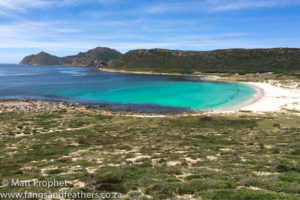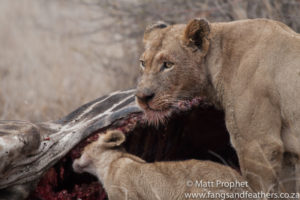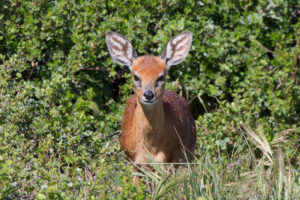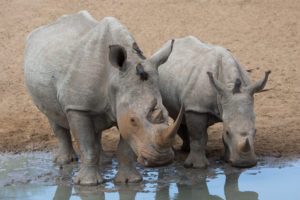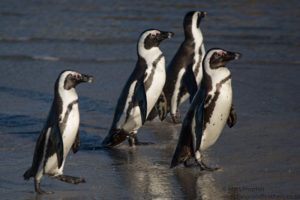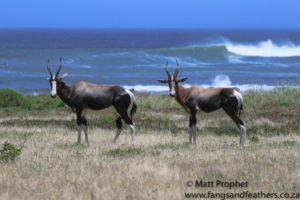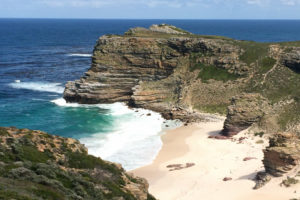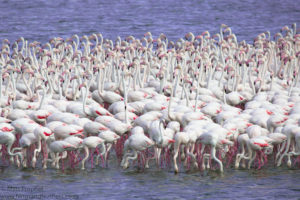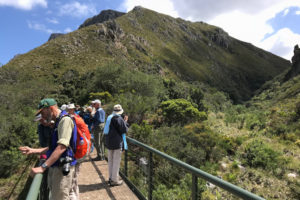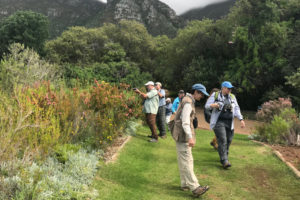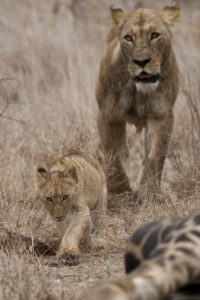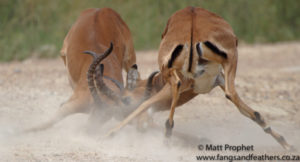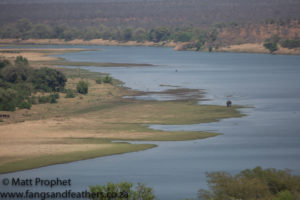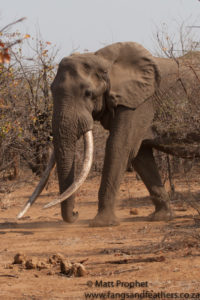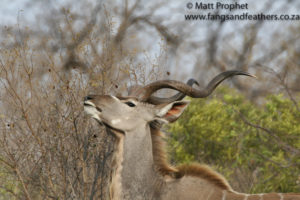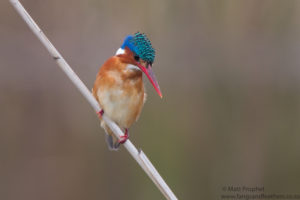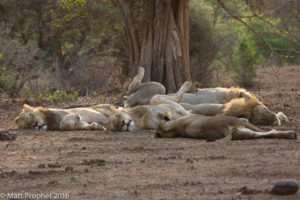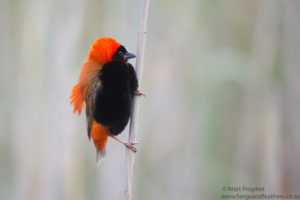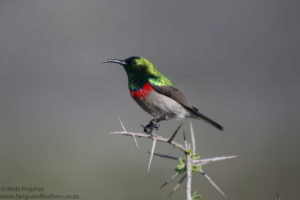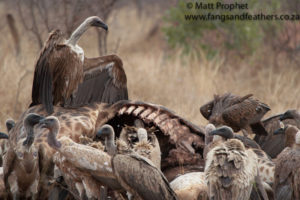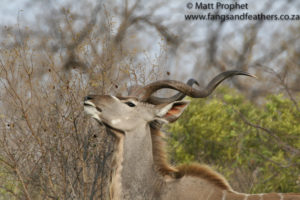South Africa's Fangs & Feathers
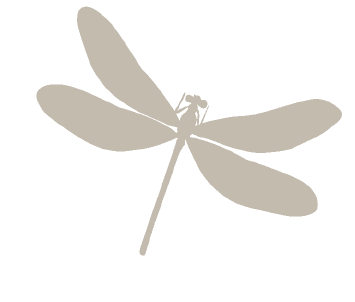
September 19-30, 2022
$5,250 | ($500 deposit due upon registration)
9 participants max
Alone male lion roars in the distant savanna as the African sunset illuminates a herd of cape buffalo crossing the river below you. Congregations of herons and egrets turn their heads to follow a crocodile swimming upstream towards a half-submerged pod of hippos. Looking up from your open jeep, the acacia above you is adorned with dazzling kingfishers, sunbirds, and lilac-breasted rollers. Later, you find yourself sipping morning tea at a breathtaking promontory over an endless ocean. A penguin colony bustles in the foreground, while spouting Southern right whales swim up coast beyond. In the steppes behind you, an assembly of endemic antelope and zebra stroll through fresh grass and curious spring wildflowers. Experience the birdlife and megafauna of your dreams on this great South African safari.
Additional Information
Physical Requirements: A moderate level of fitness is required. We will not be doing anything too strenuous. During the Cape Town leg we will be doing a bit of walking and clocking up around 3-4 miles on some days. We manage things as we go and if one particular person does struggle, one of the guides will be assisting those persons.
All of the walks will be on footpaths, and tracks, so underfoot conditions will vary from rocky, grassy to gravel type substrates.
Climate: September is a moderate time of the year in Southern Africa. Day time temperatures in Kruger should be high 60Fs to high 80Fs, with evenings cooling down to about 60 degrees. Early morning game drives in Kruger will be chilly, as we will most likely be in open vehicles. For this reason, wear layers so we can shed clothes as temperatures rise with the sun.
Cape Town has very variable weather, we do experience cold fronts at this time of the year where we may get rain and strong wind. Although we are into Spring and these conditions are less likely. Day time temps are going to be 60-75F, and evenings could drop to 50F. Some of the days could be windy: travelers should plan on wearing long trousers and long-sleeve Colombia type travel shirts on most days.
Health Considerations: Malaria risk is very low in Kruger at this time of the year. Taking anti-malarial medications is somewhat of a personal choice for this tour, but we don't feel it is necessary. Individuals should consult with their doctors and make their own decision.
Transportation: The land transportation will be done in minibuses with A/C. We will travel in open-top safari vehicles in Kruger N.P. All domestic flights will be on commercial airlines.
Matt Prophet is the owner of Fangs and Feathers Pty Ltd. His passion for the natural world and conservation thereof guided him into a career in wildlife conservation and ecotourism. During that 18 year period Matt worked in both the private and government sector for companies and organisations like Angolan Adventure Safaris (Angola 1997-1999), Namibia Country Lodges (Namibia 2000), Cape Nature (South Africa 2001-2008), Peace Parks Foundation (Mozambique 2008-2010), Queensland Parks and Wildlife Services and the Department of Environment and Conservation (Australia 2011-2016).
In 2016 he decided to start his own business which would allow him to share his knowledge, experience and passion for nature with others on his Fangs and Feathers Wildlife Adventures and Birding Tours.
Matt's experience in wildlife conservation is what separates him from many other operators and guides. His intimate understanding of wildlife and his ability to locate birds and mammals maximizes your odds of seeing your target animals.
Matt is an accredited South African nature guide, qualified to lead tours in all regions of South Africa. He maintains a Southern Africa birdlist which is currently 827 species and an Australasian species list of over 500 species.
----
Our NBNC guide is Staff Naturalist, Sean Beckett. Sean guided wildlife safaris and birding trips across North America for the last decade, primarily in Yellowstone National Park. His background includes several avian research positions ranging from Atlantic Puffin monitoring in coastal Maine to Ferruginous Pygmy-owl sampling in northern Mexico. Sean holds a M.S. from the University of Vermont's Field Naturalist program.
Accomodation while in Kruger is all serviced South African National Parks Board chalets. The units have beds with linen and pillows, showers, toilets, and air conditioning. Rooms often have a small kitchen and sitting area. There will be variation in the unit type from camp to camp and we will use a combination of rondavels and double chalet rooms.
Two meals a day will be provided, and will either utilize the rest camps local restaurants, which offer a range of foods from salads, vegetable, meat and poultry dishes, or we will organize our own group catering. Fire is a big part of South African culture and we barbecue or “braai” as we call it here on a weekly basis, even at our own homes. Eating and relaxing by the fire is also a nice way to talk about our daily highlights and share in our experiences together. At Blyde River Canyon our meals will be at the lodge we utilise.
In Cape Town, we will be staying in a comfortable three star type guesthouse where breakfast will be had each morning. Dinners will either be at the guesthouse or at local restaurants in Simonstown or Noordhoek depending on which accommodations we use.
Includes:
- Accommodations
- Breakfasts and Dinners
- Ground transport in Toyota Quantums / similar
- Open safari vehicles in Kruger
- Domestic flights within South Africa during the trip
- Entrance fees
- Bottled water in vehicles whilst travelling
- Expert naturalist and birding guide
- Expert NBNC trip leader
Excludes:
- Airfare from USA to Johannesburg and from Capetown to USA.
- Travel and medical insurance
- Lunches
- Alcohol
- Gratuities
- Items of a personal nature
Ready to go to South Africa?
Email [email protected] to get signed up.
Itinerary
We will arrive in Johannesburg today and be shuttled from the international airport to the Africa Sky Guest House on the outskirts of the city. Here we will settle in, catch up on jet lag, have a meal, and prepare for the journey.
You’ll meet with your guide at Africa Sky Guest House in the morning. We then make our way into the Drakensberg Escarpment, which stretches down the eastern side of South Africa to the Eastern Cape Province. It’s about a 5-hour drive and we make a lunch stop in the quaint town of Dullstroom or Graskop, depending on our timing.
After lunch we drive to our chosen resort at Blyde River Canyon Nature Reserve, the third largest canyon in the world. The area is wonderfully scenic, with incredible cliffs stepping down to the Blyde River, which runs along the bottom of the canyon far below. The resort is situated close to the canyon, offering private view sites and some wonderful nature walks. It’s a great place to unwind after your long flight and before the excitement of the Kruger safari begins.
This region represents a transition between the cooler grassy highlands and the hot savanna. We’ll begin seeing birds including: Swee Waxbill, White-throated Robin-Chat, Lazy Cisticola, Striped Pipit, Yellow-fronted Tinkerbird, Cape Rock-Thrush, Mocking Cliff-Chat, Alpine Swift, Collared Sunbird, Greater Double-collared Sunbird, and Brown-hooded Kingfisher.
After checking in we can relax and in the late afternoon and may head to the resort’s upper view point to see the sunset, turning the rusty cliffs a brilliant shade of orange. We’ll then have some time to freshen-up before dinner in the resort’s restaurant.
We conduct a morning bird walk while viewing the spectacular canyon formations along the Kadisi Stream, looking out for birds such as Cape Rock Thrush, Striped Pipit, Mocking Cliff Chat, Yellow-breasted Apalis, Greater Double-collared Sunbird, Mountain Wagtail, Olive Bush Shrike, Brown-hooded Kingfisher, White-throated Robin Chat and many others. There are also Chacma baboons and vervet monkeys living in the area.
After a hearty breakfast, we’ll pack and depart for the incredible Kruger National Park, entering via its Orpen Gate. We then spend the rest of the day searching for game as we make our way to Satara Rest Camp, where we will spend two nights. The mammal diversity is astounding here. You can expect to see elephant, buffalo, hippopotamus and possibly even lions, leopards or cheetah on the first afternoon! Antelope such as impala, kudu, waterbuck as well as blue wildebeest and Plains zebra can also be expected.
We will arrive in camp in the late afternoon and have some time to rest before meeting for dinner. The camps in the park are safe from dangerous game, so you will be able to wander the campgrounds and take in your wild surroundings at your leisure.
Today we spend the entire day exploring the vicinity of Satara, one of the best big cat areas in any park in Africa. We’ll embark on our first morning drive to look for leopard and lion. Excitement levels will be high as we encounter some amazing mammals.
We generally spend our time back at the camps during the warmer periods of the afternoon between 11 and 3, as this coincides with low activity periods for predators. It also provides us with an opportunity to have lunch, recharge our batteries, and enjoy the birds and smaller animals that occur within the large campground.
In the afternoon we continue our wildlife watching on an evening safari drive. In Kruger, you can really expect the unexpected: you never know what you will see next. While we have dinner in the rest camp, we’re likely to hear all sorts of nighttime sounds, such as owls, nightjars, jackals, the occasional far roars of lions, or the whoops of spotted hyaenas.
After an early morning game drive, we have breakfast back at Satara before heading south to Lower Sabie Rest Camp 50 miles away. Along the way there is a very good chance of lion, elephant and buffalo and perhaps white rhino.
On reaching Lower Sabie, we will check-in to our chalets in a beautiful, shaded rest camp situated on the southern bank of the Sabie River in the south-eastern corner of Kruger National Park. The river is the life-blood of the area, especially during the dry season, when animals tend to congregate along the river’s edge. In addition to the riverine habitat, the Basalt Plains add to the mix of habitats and provide important grazing habitat for many ungulates.
The combination of perennial water and diverse habitat is why the Lower Sabie region provides some of the most productive game viewing in the park. Time can be spent on the large wooden deck outside the restaurant overlooking the river, enjoying numerous pods of hippopotamus and Nile crocodiles. Waterbirds are diverse, and you will see different storks, herons, egrets, ducks, geese, and hopefully the sought-after White-crowned Lapwing.
Sunset Dam is just a few minutes drive from the camp, and provides a haven for hippopotamus, Nile crocodile and water birds. It is a great place to set up for an extended photography session during the day. Two nights in the area will give us ample time to explore the area.
Our morning game drive is bound to deliver something exciting, and once again we will focus on locating predators like lion, leopard, cheetah and African hunting dog. We stop along the way for anything that interests the group, such as small predators like the various species of mongooses, black-backed jackals, and caracal.
Snakes seen on our drives may include African rock python, black mamba, snouted cobra and puff-adder. Exiting the vehicle at unauthorized sites is not permitted in the park, so we will be viewing much of the wildlife (snakes included!) from the comfort and safety of our safari vehicle.
The drive along the Sabi River is beautiful, and African elephant are commonly seen along its banks. The large trees often provide great views of different eagle and vulture species, and it is also a good area for the elusive leopard!
Midday is spent around the rest camp. Spend the afternoon strolling around birding, or photographing and observing the interaction of large game in the riverbed below.
During the afternoon drive we’ll search again for large predators, which remains the primary objective for the duration of our Kruger leg of the tour. We are sometimes lucky enough to come across a fresh kill, with lion and dozens of vultures in attendance.
After our morning drive and breakfast, we head to our final rest camp for the Kruger leg of our tour. Pretoriuskop Rest Camp is situated in the southwest corner of the park, and is dominated by broad-leaf woodland and large granite domes towering over the surrounding plains. Game viewing in this region is variable. In the spring it is often the first part of the region to receive rain, resulting in the first green flush of sprouting grasses.
Grazers such as Burchell’s zebra, blue wildebeest and buffalo move into the area, and the area sometimes produces rarer antelope species such as tsessebe, sable and Lichtenstein’s hartebeest.
There’s a fair chance of seeing African wild dog here. A known pack frequents the area from time to time, hunting the abundant Impala in the area. An encounter with these wide-ranging predators would be an incredible, once-in-a-lifetime sighting! This area also produces good sightings of leopard and lion.
The birding is different than other areas of the park. Target species will include Bushveld Pipit, Retz’s and White-crested Helmet-Shrikes, Dark Chanting Goshawk, African Cuckoo Hawk, Lizard Buzzard, Southern-banded Snake Eagle, Bennett’s Woodpecker, Yellow-throated Longclaw, Yellow-throated Petronia, Pale Flycatcher, Croaking and Lazy Cisticolas and Scarlet-chested Sunbird. We should arrive in the early afternoon. After checking in, we’ll head out on an afternoon game drive before freshening up for dinner.
We depart Kruger after an early morning drive and quick breakfast, then head for Nelspruit, where we take an easy, direct flight to Cape Town. We arrive in Cape Town in the late afternoon, then to Simonstown on the eastern seaboard of the Cape Peninsula, which will be our base for the next few days. Simonstown is well-situated for a series of day tours based from Whale View Guesthouse or similar lodges a stone’s throw away from False Bay. Southern right, Bryde’s and humpback whales are regularly seen from the guesthouse.
This afternoon, we will take a scenic drive into Simonstown, stopping along the way at various viewpoints overlooking the Atlantic Ocean from where we would look for whales and dolphins. We will also see our first endemic birds here, including Cape Sugarbirds, Orange-breasted and Southern Double-collared Sunbird, Cape Bulbul, Cape Siskin, and Karoo Prinia.
The views of the rugged, steep coastline are exceptional. The native “fynbos” which grows on the mountains and throughout this province is one of the most diverse floral biomes in the world, and characterised by a high diversity of proteas, ericas and flowering bulbs. We’ll finish the day with a nice dinner at our guesthouse or at a local Simonstown restaurant.
The order of the next two days is governed by Cape Town’s unpredictable weather. Your guide will determine which locations are visited on which day, and will keep the program flexible. You can expect to the visit the following locations during your time here: The Cape of Good Hope section of Table Mountain National Park, Kirstenbosch National Botanical Gardens, the West Coast National Park, Strandfontein Birding Area, Kommetjie, and the Boulders/Stony Point Penguin Colony.
Today, however, we aim to explore the Cape Peninsula and will travel to the coastal town of Kommetjie after breakfast. We’ll walk along a coastal pathway to Slangkop Lighthouse where we will see a good number of seabird species including Crowned, Cape, and White-breasted Cormorant, Kelp and Hartlaub’s Gull, Greater-crested Tern, Grey Heron, Sacred and Glossy Ibis, and possibly Cape Gannet offshore. The surrounding native shrub thickets are also home to range of endemic species such as the Southern, Double-collared, and Malachite Sunbird, Bokmakierie (a stunning shrike), Cape Robin Chat, Southern Boubou, Cape Grassbird, Karoo Prinia and Grey-backed Cisticola.
We then drive along the west coast of the Cape Peninsula towards the Cape of Good Hope (aka “Cape Point” or “The Cape of Storms”), which is the southern part of the Cape Peninsula lying within Table Mountain National Park. As we travel along the coast we will stop to watch birds and whales. At the Cape of Good Hope we will be searching for an endemic antelope species called the bontebok, which almost became extinct in the early 1800s. These striking, tan-and-white grazers can be found wandering the coastal plains of the reserve.
Cape eland, the largest of the world’s antelope species is another mammal we hope to see on this day. With some luck we might also encounter a small herd of Cape mountain zebra.
We usually take a walk or a cable car ride to the lighthouse at Cape Point at the tip of the Cape. Contrary to popular belief, this is not where the Atlantic and Indian Oceans meet, but where the Agulhas and Benguela currents are said to converge. The views from this point are incredible, and full of seabirds. White-necked Raven, Rock Kestrel, Peregrine Falcons, and the endemic Cape Siskin are all possibilities here. If the weather is warm, we will most likely see reptiles such as Southern Agama and Black Girdled Lizard.
After our time here, we drive back through the reserve and have a good chance of encountering chacma baboons. These baboons are larger and with a shaggier coat than the ones you will see in Kruger, despite being the same species. They are also unique in having adapted to forage in the inter-tidal zone.
We then head to Boulders Penguin Colony, one of only two mainland-breeding colonies for the endangered African Penguin. The other colonies are situated offshore on islands around the South African coastline. The late afternoon is usually the best time to observe the penguins as they return from sea in an afternoon light ideal for photography. You can also expect to see rock hyrax between the bushes at Boulders as we stroll around the walkways. We then head back to the guesthouse have dinner and prepare for the next day.
Today we make an earlier start and will travel to the West Coast National Park (WCNP), situated approximately 60 miles north of Cape Town.
The Fynbos in the park is different to that of the Peninsula. Called “Strandveld,” this beach vegetation is dominated by Restios rushes and thorny scrub. It contains a different set of biodiversity than elsewhere on the tour. Another feature of the park is a large inter-tidal lagoon called “Langebaan Lagoon.” This is a very good spot for migratory shore birds during the spring months and is a central feature of this national park.
Some of the target mammals here will include: Cape eland, bontebok, steenbok, Cape mountain zebra, springbok, common duiker and Cape grey mongoose. We’ll keep an eye out for these as we drive and walk around. A visit to one of the beaches may produce the diminutive benguela, and a current endemic, the Heaviside’s dolphin, if we are lucky.
Some of the target birds here include species such as: Black Harrier, Karoo and Large-billed Lark, Cape Weaver, Bar-throated Apalis, Chestnut-vented Warbler, Grey-winged Francolin, African Rail, Yellow and White-throated Canary, Bokmakierie and many more.
The flowers during August and September (Southern Hemisphere spring) are amazing and if there has been good winter rain, you will see incredible, photogenic displays of colour in the park. Lunch will either be in the form of packed lunches or we utilise a local restaurant.
We usually depart the park mid-afternoon to make our way back to Simonstown. A stop at Darling Hills to look for Blue Crane, South Africa’s National Bird, is a possibility if time allows.
After breakfast we drive to the Kirstenbosch National Botanical Gardens on the eastern slopes of Table Mountain. This magnificent 800-hectare botanical gardens which streches into the edges of Table Mountain National Park is a haven for plants and birds. We spend our time walking through the area looking at the flora and special birds like the Orange-breasted Sunbird and Cape Sugarbird, both endemic to the fynbos biome. It is a great place to photograph these nectivorous species as they feed in richly colored flowering proteas which adorn the slopes.
We sometimes see small grey mongoose and four-striped field mouse as we meander along. Kirstenbosch is also good for raptors and we keep an eye open for the scarce Rufous-chested Sparrowhawk and African Goshawk that live here. Other target species hard to find elsewhere in the Cape include: Forest Canary and the elusive Lemon Dove (reliable here over the past few years). Malachite and Amethyst Sunbird, Cape Spurfowl, African Swee Waxbill, Olive Woodpecker, Cape Batis, and African, Paradise, and Dusky Flycatchers are other target birds on this morning.
From Kirstenbosch we will make our way to the Intaka Islands that lie just to the north of the city. This popular birding area can be good for a number of waterbirds such as: Purple Heron, African Darter and the Malachaite, Giant and Pied Kingfishers. We spend about an hour here before settling in at a local eatery for some lunch. The alternative to this is to visit Rondevlei Nature Reserve on-route to Strandfontein Birding area, another stop that can be worthwhile, but we will make this decision in the morning.
Strandfontein Birding Area or sewage works as it is locally referred to as, is situated on the Cape Flats in the bight of False Bay. You will be impressed by the numbers and diversity of ducks, geese, and other waterbirds that live and visit here. You should see hundreds of Greater Flamingos and possibly Lesser Flamingoes too. Great White Pelicans are regular along with various Old World warblers and other passerines. Strandfonetin is also one of the better places to see the endemic Cape grysbok, an diminutive browsing antelope whuch resides in the thickets between the pans and is largely restricted to the fynbos biome. Small mammals include Water and Cape Grey Mongoose and other target birds include Maccoa Duck, Hottentot Teal and African Marsh Harrier. We then depart for a dinner in Simonstown after having had a day of good exercise and a wonderful time in nature.
Depending on international departure flight times, we may conduct another activity today. If your flights were in the morning, we would transfer you to the airport directly after breakfast. For midday flights, we arrange a short excursion before heading to the airport. If the flights are during the afternoon or evening, we will travel along the Hottentot’s Holland Mountains to the seaside town of Rooiels, which is situated on the eastern side of False Bay. At Rooisels we embark on a 2-mile walk along a gravel track with the ocean on our one side and the mountain on our other.
This is a very productive outing for various bird species, particularly Cape Rockjumper Penguins, Cape Sisken, Cape Rockthrush and Ground Woodpecker. We might see a little antelope of rocky areas called a Klipspringer. From here we take the short drive to Betty’s Bay where we spend a couple of hours wandering around Harold Porter Botanical Gardens, which offers beautiful views and some fine birding. We usually stop for lunch at one of the local restaurants in Betty’s Bay. If time allows, we will visit Stony Point penguin colony to see African Penguins and Bank, Crowned, Cape and White-breasted Cormorants. This is also a good place to see rock hyrax again and reptiles like blue-headed agama and Cape crag lizard.
After a final bag check, we take the drive to Cape Town International Airport for you to check-in for your homebound flights. International flights usually require flying from Cape Town to Johannesburg to catch a flight over the ocean. We are confident that this tour will be the trip of a lifetime.
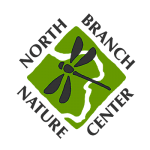
713 Elm Street
Montpelier, Vermont 05602
(802) 229-6206
Hours: Center Open Monday-Friday 9-4
Trails Open 24/7


